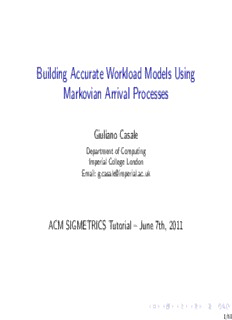
Markovian Arrival Processes PDF
Preview Markovian Arrival Processes
Building Accurate Workload Models Using Markovian Arrival Processes Giuliano Casale DepartmentofComputing ImperialCollegeLondon Email:[email protected] ACM SIGMETRICS Tutorial – June 7th, 2011 1/68 Outline Main topics covered in this tutorial: • Phase-type (PH) distributions • Moment matching • Markovian arrival processes (MAP) • Inter-arrival process fitting Important topics not covered in this tutorial: • Queueing applications, matrix-geometric method, ... • Non-Markovian workload models (e.g., Pareto, matrix exponential process, ARMA processes, fBm, wavelets, ...) • Maximum-Likelihood (ML) methods, EM algorithm, ... • ... 2/68 1. PH DISTRIBUTIONS 3/68 Continuous-Time Markov Chain (CTMC) Notation • m states • λ ≥ 0: (exponential) transition rate from state i to j i,j • λ = (cid:80)m λ : total outgoing rate from state i i j=1 i,j • Infinitesimal generator matrix: −λ λ ... λ 1 1 1,2 1,m λ2,1 −λ2 ... λ2,m 1 Q = ... ... ... ... , Q1 = 0, 1 = ... λ λ ... −λ 1 n,1 n,2 m • π(t) = π(0)eQt: state probability vector at time t • π (t): probability of the CTMC being in state i at time t i • π(0): initial state probability vector 4/68 Example 1.1: CTMC Transient Analysis Initial state: π(0) = [0.9,0.0,0.1,0.0] −4 4 0 0 4 −7 2 1 Transient analysis: Q = 2 3 −5 0 (cid:88)∞ (Qt)k 2 0 0 −2 π(t) = π(0)eQt = π(0) k! k=0 A Sample Path Transient Probabilities 1 4 0.8 current state23 state probabilities00..46 0.2 1 0 5 10 15 20 tim2e5 30 35 40 45 00 0.5 1 t1im.5e 2 2.5 3 5/68 Phase-Type Distribution (PH) • Q: CTMC with m = n+1 states, last is absorbing (λ = 0) n+1 −λ λ ... λ λ 1 1,2 1,n 1,n+1 λ −λ ... λ λ (cid:20) (cid:21) 2,1 2 2,n 2,n+1 T t Q = 0 0 = ... ... ... ... ... λ λ ... −λ λ n,1 n,2 n n,n+1 0 0 ... 0 0 • T: PH subgenerator matrix, T1 < 0 • t = −T1: exit vector • “No mass at zero” assumption: π(0) = [α,0], α1 = 1 References:[Neu89] 6/68 Example 1.2: Absorbing State Probability Initial state: π(0) = [α,0.0] = [0.9,0.0,0.1,0.0] −4 4 0 0 −4 4 0 0 4 −7 2 1 Q = ,T = 4 −7 2 ,t = −T1 = 1 2 3 −5 0 2 3 −5 0 0 0 0 0 1 1 state probabilities000...468 orbing state probability000...468 0.2 bs0.2 a 0 0 0 5 10 15 0 5 10 15 time time 7/68 PH: Fundamental Concepts Basic idea: model F(t) = Pr(event occurs in X ≤ t time units) as the probability mass absorbed in t time units in Q. • Semantics: entering the absorbing state models the occurrence of an event, e.g., the arrival of a TCP packet, the completion of a job, a non-exponential state transition in a complex system • Understanding the absorption dynamics: ∞ ∞ (cid:80) (Tt)k (cid:80) Tk−1tkt π(t) = π(0)eQt = π(0) k! k! k=0 k=1 0 1 • Using the definition t = −T1, we get π(t) = [αeTt,π (t)], π (t) = 1−αeTt1 n+1 n+1 where π (t) is the probability mass absorbed in t time units. n+1 8/68 PH: Fundamental Formulas PH distribution: F(t) = Pr(event occurs in X ≤ t) =def 1−αeTt1 • PH representation: (α,T) • Probability Density function: f(t) = αeTt(−T)1 • (Power) Moments: E[Xk] = (cid:82)+∞tkf(t)dt = k!α(−T)−k1 0 • (−T)−1 = [τ ] ≥ 0 i,j • τ : mean time spent in state j if the PH starts in state i i,j • Median/Percentiles: no simple form, determined numerically. 9/68 Example 1.3: a 3-state PH distribution −(λ+µ) λ µ 0 α = [1,0,0], T = 0 −λ λ ,t = 0, λ ≥ 0. 0 0 −λ λ • Case µ → +∞: E[Xk] = k!λ−k (Exponential, c2 = 1). • Case µ = λ: E[Xk] = (k +1)!λ−k (Erlang-2, c2 = 1/2) • Case µ = 0: E[Xk] = (k+2)!λ−k (Erlang-3, c2 = 1/3). 2 • No choice of µ delivers c2 > 1 Remarks: Squared coefficient of variation: c2 =def Var[X]/E[X]2 10/68
Description: